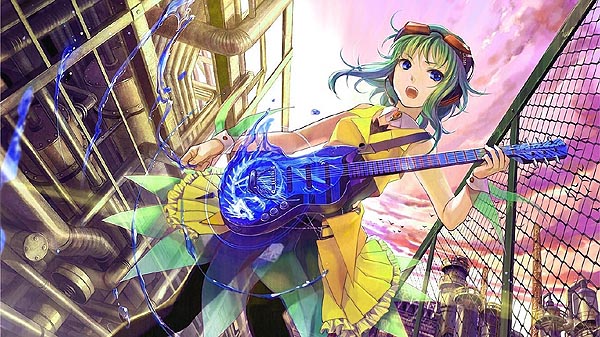Anime's Popularity Welcomed by Papermakers for Hand Drawn Requirements
![]() Print this Article | Send to Colleague
Print this Article | Send to Colleague
Manga and anime (Japanese culture linked drawings and animation) has become a very old tradition in Japan. But fast forward to the present and suddenly, in the 2010s, it is popular all over the world. The anime and manga industry in Japan is a major source of employment in the country, including the paper industry.

Pictured above: A brightly dressed anime girl "plays" an imaginatively modified blue psychedelic electric guitar during a scene set within an industrial complex. She is now closest to what is identified in dialog as a paper mill.
Unlike U.S. Television programs, there are literally thousands of manga artists. Though dedicated to one of the last arts that promote the heavy use of paper drawing books bound with creative work, very few of them become popular. But that is beginning to change somewhat as anime fandom digs deeper to find works people will like. Outside of Japan, here in the U.S., there are now distinguished tastes for the already unique style of artwork that cannot be mistaken for other types of animation.
Anime is not simply another form of animation. It contains many layers and many shapes and micro-textures not yet ready to be rendered to a producers quality using CGI or other digital editing/cleaning tricks. So, what are the problems in using digital medium when trying to make real anime?
Here are just a few common issues:
1. Not every studio can afford to give every animator a pentab and upgrade their systems for hi-tech work. (At present there are few studios like MAD HOUSE with high quality 3D And Digital output).
2. Artists draw on paper quicker than they do on a screen or pentab. This is going to remain in effect for at least another generation because most parents in Japan or the U.S. don't yet give them I-Pads in their early childhood. Quora offers the suggestion that this is why children, both Japanese or American, are more attracted towards an empty sheet they can modify
3.The artists can't rely on technology since they work on very, very tight deadlines. Paper doesn't crash, freeze, or take too long to load. (Each episode takes only 1 week of production!). Pre preproduction is done before hand.
And finally. there's one major reason that has nothing to do with cost or learning curb. When artists draw anime to make their films, television shows, or comic book series complete with 3-D animation or even CGI enhancement, it nearly always tends to be awkward, unappealing, and lifeless to artists, critics, and fans alike. For this reason, the animation/drawing paper supply industry can consider Japan's contribution to what is now becoming a global admiration for anime to represent a new but rare and much needed paper ally in media once again, at least for the foreseeable future.
It may be wise for drawing paper suppliers to reach out to anime artists and promote or sponsor the Japanese style production in new markets where P&W paper usage remains popular (such as in India).
It may be wise for drawing paper suppliers to reach out to anime artists and promote or sponsor the Japanese style production in new markets where P&W paper usage remains popular (such as in India).
Paper suppliers and salesmen may want to consider the importance of making the lies of a European or South American anime production and/or broadcast tour in hopes of advancing the more paper-intensive style outside of Japan and the U.S. where it's proven to have a cross-cultural appeal.
Finally, drawing paper suppliers are approaching the time they know it will be in their financial best interests to turn away from the progressively obsolete cartoon medium (dot-matrix Comics on newsprint), instead of forming a more exclusive yet workable long distance relationship with Japanese anime due to the fact that it is highly popular with younger Americans most all under age 40. For traditional Western animation, most nearly all U.S. and Canadian animation works produced by 2016 are now done using special studio software made by long-established companies like Adobe that have helped reinforce the rise of hands free digital animation that moves and mixes with a more seamless and much less tedious method of producing moving artwork. Some of the largest U.S. animated franchises such as The Simpsons and Family Guy are now rendered almost exclusively in a digital studio.


